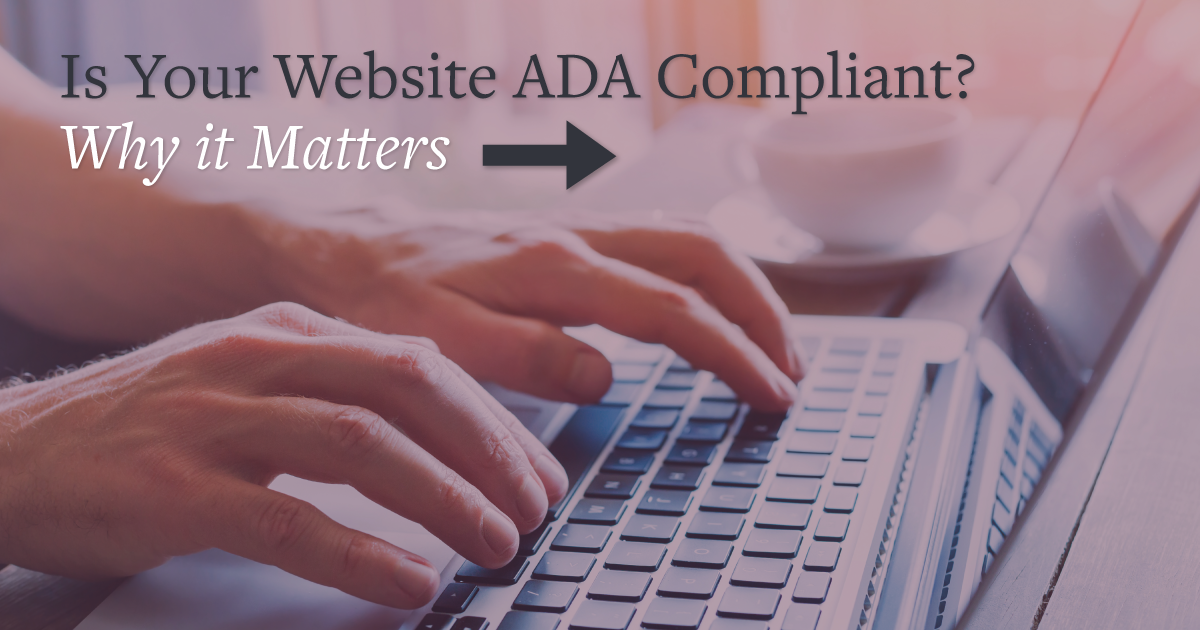
ResourcesEverything in One Place
Is Your Website ADA Compliant? Here's Why it Matters.

A rising concern for home builders across the US is ADA compliancy. While this has been seen as more of an issue for larger, national builders, we've seen this become a priority for virtually every builder that has a website. Bottom line, if you aren't ADA compliant, you are at risk. There have been builders over the last two years that have been sued successfully for lack of website accessibility, specifically by users who are visually impaired.
Fines from the Department of Justice start at $75,000.
There’s a detailed outline (WGAC 2.0) of the areas on your website you need to address to make sure you are compliant. We've listed them below, but make certain that your web developer is also aware of these elements as you move forward.
Images Need Text (Alt tags)
For users that are visually impaired, your site’s images need to have alternate text describing what the image is. Their screen reader—a tool that reads the screen aloud to the user—needs to be able to decipher what the image or button is by reading the alternate text. Doing so also ensures SEO best practices are met and helps improve the customer experience.

Don’t Use PDFs
PDFs are read as image based formats, which means that sometimes screen readers or text enlargement programs for the visually impaired cannot decipher this information. All in all, avoid posting documents in PDF format.
Font Style & Size
When designing a website, consider a font style that’s easier to read and ensure font size and color can be adjusted. You don’t want to inhibit any users, as those who are visually paired often need high-contrast colors and larger font sizes to see the text presented on your site.
Images & Video
It’s recommended that photos are visibly easy to see, in high resolution and, while it might be a no-brainer, they also need to be relevant to your content. As a rule of thumb, avoid blinking images or overly animated graphics.
Ensure video and audio are clear and, to accommodate the hearing impaired, include captions on all videos. For audio and video accessibility, use a universal player, such as MP3 and MP4 file formats.
Colors
Important elements, such as CTAs (call to action) or buttons need to include contrast. Less contrast can create confusion as to where the user should click or where the button will take them.
To determine if a website is ADA compliant, the Department of Justice uses WGAC 2.0 (Website Content Accessibility Guidelines). Website content must be:
Perceivable
Operable
Understandable
Robust
Not only does ADA compliance help improve the user experience and avoid legal troubles, but it also can help SEO rankings.
“Becoming ADA compliant will also benefit the SEO of your website by improving the readability, which will have a positive impact within search engines and rankings (SERPs),” Builder Designs SEO and Google Ads expert Jon Hurst says.
ADA site compliance isn’t done and over with the moment you hit “Launch” on your new site. These standards continually change and evolve! And just like taking care of a home throughout the years to ensure it’s longevity, you need to do so with your new site. So, post-launch of your site, be sure to stay up-to-date on ADA compliance standards, so you can keep your website updated accordingly, retain happy customers and protect yourself against legal action.
Have questions about ADA compliance on your website? We’re here to help. Contact Amber and we’ll show you how your website can adhere to ADA standards.
Latest Posts
May 12, 2025 | Blog
The Scrolling Homebuyer—How Builders Can Capture Today’s Digital-First Buyer
February 19, 2025 | EBook
2024 Builder Data Year In Review
December 19, 2024 | Blog
Mortgage Rate Projections: Two Paths Forward or Uncharted Territory?
October 17, 2024 | Podcast
INBOUND 2024: AI Trends, HubSpot Innovations and More
October 3, 2024 | Webinar
We Know What Works Replay
October 1, 2024 | Blog
Buyers Saved Just $20/Month on Their Mortgage This Year – Here’s Why It’s Happening
September 26, 2024 | Blog
How the Fed Rate Cut Could Impact Mortgage Rates: What Builders Need to Know
September 19, 2024 | Blog
We Know What Works—Builder Designs’ Proven Strategies for 2025
August 9, 2024 | Podcast
Builder Buzz | Essential Takeaways from the 4ps of Marketing
Previous Article

Providing A Frictionless Experience
Next Article







